fuel pump YAMAHA YZ250F 2010 Owners Manual
[x] Cancel search | Manufacturer: YAMAHA, Model Year: 2010, Model line: YZ250F, Model: YAMAHA YZ250F 2010Pages: 196, PDF Size: 13.74 MB
Page 10 of 196
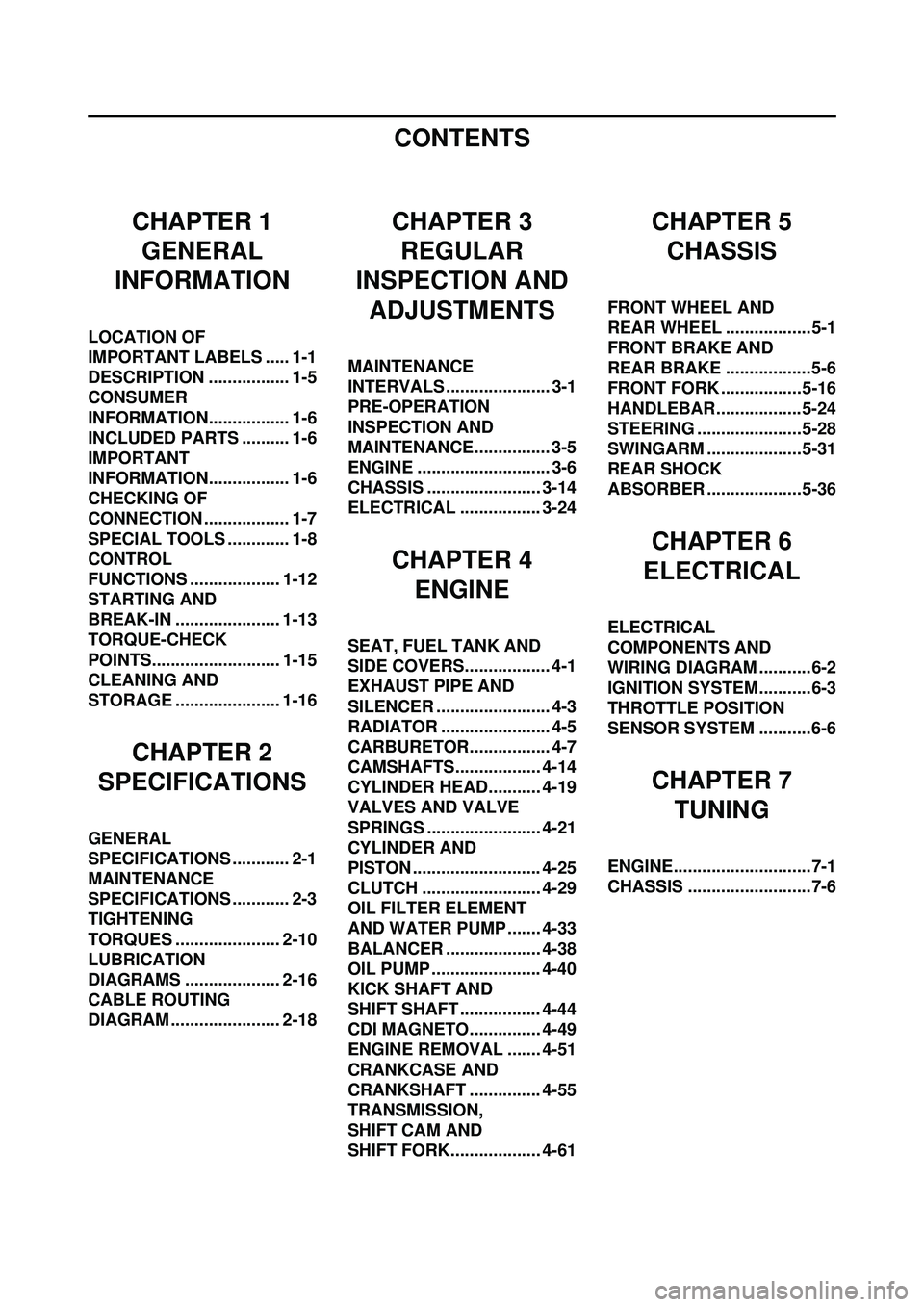
CONTENTS
CHAPTER 1GENERAL
INFORMATION
LOCATION OF
IMPORTANT LABELS ..... 1-1
DESCRIPTION ................. 1-5
CONSUMER
INFORMATION................. 1-6
INCLUDED PARTS .......... 1-6
IMPORTANT
INFORMATION................. 1-6
CHECKING OF
CONNECTION .................. 1-7
SPECIAL TOOLS ............. 1-8
CONTROL
FUNCTIONS ................... 1-12
STARTING AND
BREAK-IN ...................... 1-13
TORQUE-CHECK
POINTS........................... 1-15
CLEANING AND
STORAGE ...................... 1-16
CHAPTER 2
SPECIFICATIONS
GENERAL
SPECIFICATIONS ............ 2-1
MAINTENANCE
SPECIFICATIONS ............ 2-3
TIGHTENING
TORQUES ...................... 2-10
LUBRICATION
DIAGRAMS .................... 2-16
CABLE ROUTING
DIAGRAM ....................... 2-18
CHAPTER 3 REGULAR
INSPECTION AND ADJUSTMENTS
MAINTENANCE
INTERVALS ...................... 3-1
PRE-OPERATION
INSPECTION AND
MAINTENANCE................ 3-5
ENGINE ............................ 3-6
CHASSIS ........................ 3-14
ELECTRICAL ................. 3-24
CHAPTER 4 ENGINE
SEAT, FUEL TANK AND
SIDE COVERS.................. 4-1
EXHAUST PIPE AND
SILENCER ........................ 4-3
RADIATOR ....................... 4-5
CARBURETOR................. 4-7
CAMSHAFTS.................. 4-14
CYLINDER HEAD........... 4-19
VALVES AND VALVE
SPRINGS ........................ 4-21
CYLINDER AND
PISTON ........................... 4-25
CLUTCH ......................... 4-29
OIL FILTER ELEMENT
AND WATER PUMP ....... 4-33
BALANCER .................... 4-38
OIL PUMP ....................... 4-40
KICK SHAFT AND
SHIFT SHAFT ................. 4-44
CDI MAGNETO............... 4-49
ENGINE REMOVAL ....... 4-51
CRANKCASE AND
CRANKSHAFT ............... 4-55
TRANSMISSION,
SHIFT CAM AND
SHIFT FORK................... 4-61
CHAPTER 5CHASSIS
FRONT WHEEL AND
REAR WHEEL ..................5-1
FRONT BRAKE AND
REAR BRAKE ..................5-6
FRONT FORK .................5-16
HANDLEBAR..................5-24
STEERING ......................5-28
SWINGARM ....................5-31
REAR SHOCK
ABSORBER ....................5-36
CHAPTER 6
ELECTRICAL
ELECTRICAL
COMPONENTS AND
WIRING DIAGRAM ...........6-2
IGNITION SYSTEM...........6-3
THROTTLE POSITION
SENSOR SYSTEM ...........6-6
CHAPTER 7 TUNING
ENGINE.............................7-1
CHASSIS ..........................7-6
Page 16 of 196
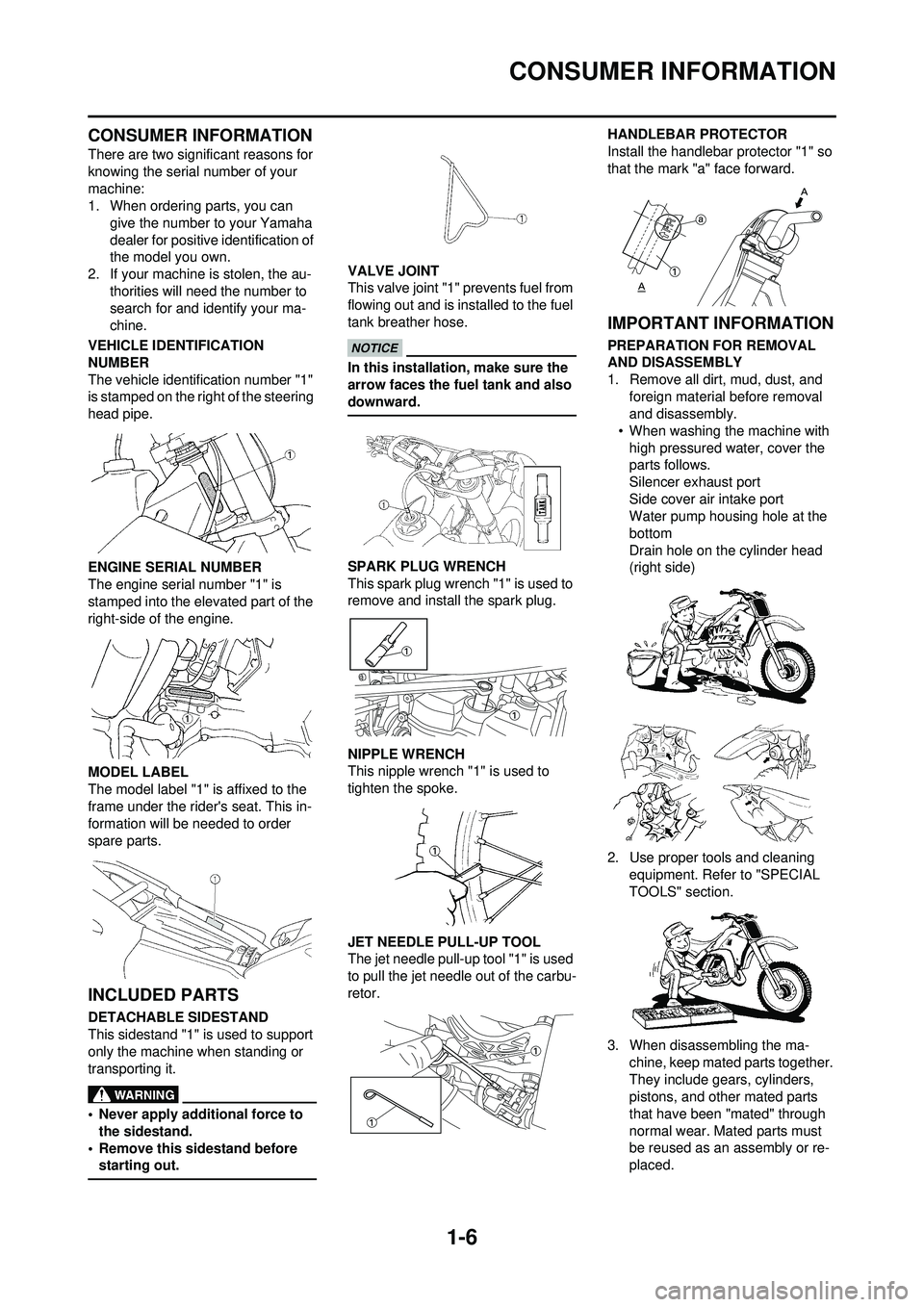
1-6
CONSUMER INFORMATION
CONSUMER INFORMATION
There are two significant reasons for
knowing the serial number of your
machine:
1. When ordering parts, you can give the number to your Yamaha
dealer for positive identification of
the model you own.
2. If your machine is stolen, the au-
thorities will need the number to
search for and identify your ma-
chine.
VEHICLE IDENTIFICATION
NUMBER
The vehicle identification number "1"
is stamped on the ri ght of the steering
head pipe.
ENGINE SERIAL NUMBER
The engine serial number "1" is
stamped into the elevated part of the
right-side of the engine.
MODEL LABEL
The model label "1" is affixed to the
frame under the rider's seat. This in-
formation will be needed to order
spare parts.
INCLUDED PARTS
DETACHABLE SIDESTAND
This sidestand "1" is used to support
only the machine when standing or
transporting it.
• Never apply additional force to
the sidestand.
• Remove this sidestand before starting out.
VALVE JOINT
This valve joint "1" prevents fuel from
flowing out and is installed to the fuel
tank breather hose.
In this installation, make sure the
arrow faces the fuel tank and also
downward.
SPARK PLUG WRENCH
This spark plug wrench "1" is used to
remove and install the spark plug.
NIPPLE WRENCH
This nipple wrench "1" is used to
tighten the spoke.
JET NEEDLE PULL-UP TOOL
The jet needle pull-up tool "1" is used
to pull the jet needle out of the carbu-
retor. HANDLEBAR PROTECTOR
Install the handlebar protector "1" so
that the mark "a" face forward.
IMPORTANT INFORMATION
PREPARATION FOR REMOVAL
AND DISASSEMBLY
1. Remove all dirt, mud, dust, and
foreign material before removal
and disassembly.
• When washing the machine with high pressured water, cover the
parts follows.
Silencer exhaust port
Side cover air intake port
Water pump housing hole at the
bottom
Drain hole on the cylinder head
(right side)
2. Use proper tools and cleaning equipment. Refer to "SPECIAL
TOOLS" section.
3. When disassembling the ma- chine, keep mated parts together.
They include gears, cylinders,
pistons, and other mated parts
that have been "mated" through
normal wear. Mated parts must
be reused as an assembly or re-
placed.
Page 23 of 196
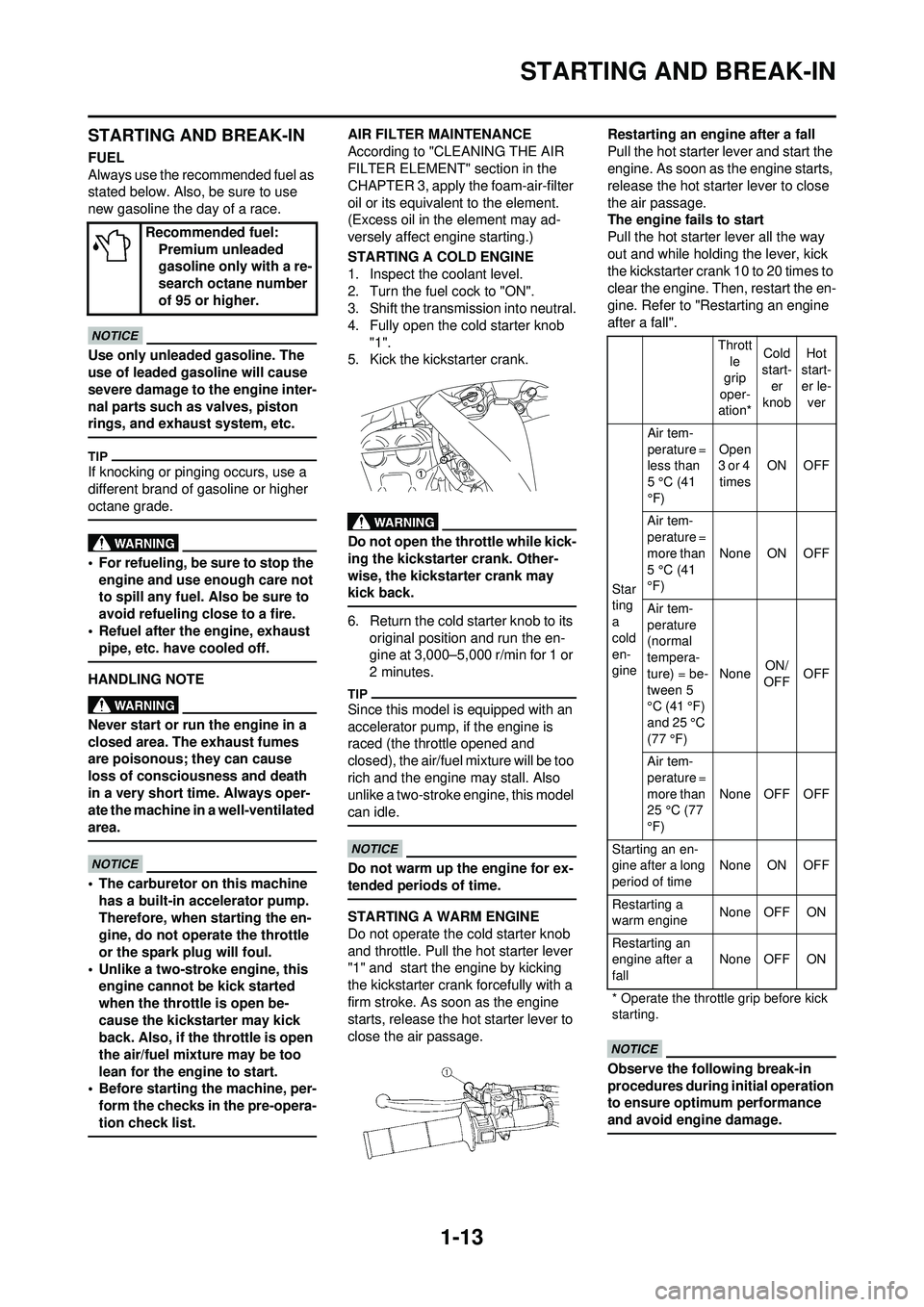
1-13
STARTING AND BREAK-IN
STARTING AND BREAK-IN
FUEL
Always use the recommended fuel as
stated below. Also, be sure to use
new gasoline the day of a race.
Use only unleaded gasoline. The
use of leaded gasoline will cause
severe damage to the engine inter-
nal parts such as valves, piston
rings, and exhaust system, etc.
If knocking or pinging occurs, use a
different brand of gasoline or higher
octane grade.
• For refueling, be sure to stop the
engine and use enough care not
to spill any fuel. Also be sure to
avoid refueling close to a fire.
• Refuel after the engine, exhaust pipe, etc. have cooled off.
HANDLING NOTE
Never start or run the engine in a
closed area. The exhaust fumes
are poisonous; they can cause
loss of consciousness and death
in a very short time. Always oper-
ate the machine in a well-ventilated
area.
• The carburetor on this machine has a built-in accelerator pump.
Therefore, when starting the en-
gine, do not operate the throttle
or the spark plug will foul.
• Unlike a two-stroke engine, this engine cannot be kick started
when the throttle is open be-
cause the kickstarter may kick
back. Also, if the throttle is open
the air/fuel mixture may be too
lean for the engine to start.
• Before starting the machine, per- form the checks in the pre-opera-
tion check list.
AIR FILTER MAINTENANCE
According to "CLEANING THE AIR
FILTER ELEMENT" section in the
CHAPTER 3, apply the foam-air-filter
oil or its equivalent to the element.
(Excess oil in the element may ad-
versely affect engine starting.)
STARTING A COLD ENGINE
1. Inspect the coolant level.
2. Turn the fuel cock to "ON".
3. Shift the transmission into neutral.
4. Fully open the cold starter knob
"1".
5. Kick the kickstarter crank.
Do not open the throttle while kick-
ing the kickstarter crank. Other-
wise, the kickstarter crank may
kick back.
6. Return the cold starter knob to its original position and run the en-
gine at 3,000–5,000 r/min for 1 or
2 minutes.
Since this model is equipped with an
accelerator pump, if the engine is
raced (the throttle opened and
closed), the air/fuel mixture will be too
rich and the engine may stall. Also
unlike a two-stroke engine, this model
can idle.
Do not warm up the engine for ex-
tended periods of time.
STARTING A WARM ENGINE
Do not operate the cold starter knob
and throttle. Pull the hot starter lever
"1" and start the engine by kicking
the kickstarter crank forcefully with a
firm stroke. As soon as the engine
starts, release the hot starter lever to
close the air passage. Restarting an engine after a fall
Pull the hot starter lever and start the
engine. As soon as the engine starts,
release the hot starter lever to close
the air passage.
The engine fails to start
Pull the hot starter lever all the way
out and while holding the lever, kick
the kickstarter crank 10 to 20 times to
clear the engine. Then, restart the en-
gine. Refer to "Restarting an engine
after a fall".
Observe the following break-in
procedures during initial operation
to ensure optimum performance
and avoid engine damage.
Recommended fuel:
Premium unleaded
gasoline only with a re-
search octane number
of 95 or higher.
Thrott
le
grip
oper-
ation* Cold
start- er
knob Hot
start-
er le- ver
Star
ting
a
cold
en-
gine Air tem-
perature =
less than
5 °C (41
°F)
Open
3 or 4 times ON OFF
Air tem-
perature =
more than
5 °C (41
°F) None ON OFF
Air tem-
perature
(normal
tempera-
ture) = be-
tween 5
°C (41 °F)
and 25 °C
(77 °F) None
ON/
OFF OFF
Air tem-
perature =
more than
25 °C (77
°F) None OFF OFF
Starting an en-
gine after a long
period of time None ON OFF
Restarting a
warm engine None OFF ON
Restarting an
engine after a
fall None OFF ON
* Operate the throttle grip before kick
starting.
Page 60 of 196
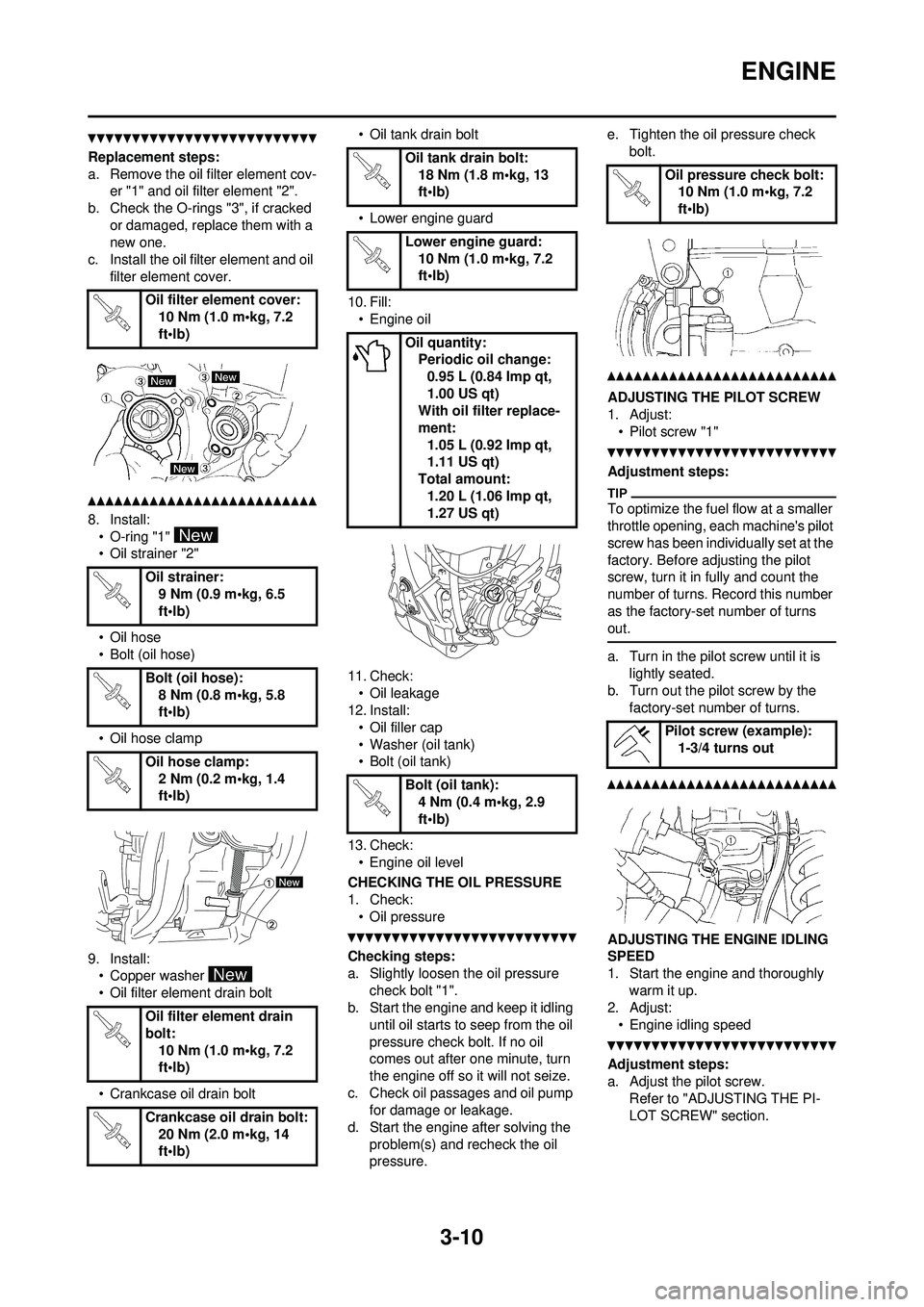
3-10
ENGINE
Replacement steps:
a. Remove the oil filter element cov-er "1" and oil filter element "2".
b. Check the O-rings "3", if cracked or damaged, replace them with a
new one.
c. Install the oil filter element and oil filter element cover.
8. Install:
• O-ring "1"
• Oil strainer "2"
• Oil hose
• Bolt (oil hose)
• Oil hose clamp
9. Install: • Copper washer
• Oil filter element drain bolt
• Crankcase oil drain bolt • Oil tank drain bolt
• Lower engine guard
10. Fill: • Engine oil
11. Check: • Oil leakage
12. Install: • Oil filler cap
• Washer (oil tank)
• Bolt (oil tank)
13. Check: • Engine oil level
CHECKING THE OIL PRESSURE
1. Check: • Oil pressure
Checking steps:
a. Slightly loosen the oil pressure check bolt "1".
b. Start the engine and keep it idling
until oil starts to seep from the oil
pressure check bolt. If no oil
comes out after one minute, turn
the engine off so it will not seize.
c. Check oil passages and oil pump for damage or leakage.
d. Start the engine after solving the problem(s) and recheck the oil
pressure. e. Tighten the oil pressure check
bolt.
ADJUSTING THE PILOT SCREW
1. Adjust:• Pilot screw "1"
Adjustment steps:
To optimize the fuel flow at a smaller
throttle opening, each machine's pilot
screw has been individually set at the
factory. Before adjusting the pilot
screw, turn it in fully and count the
number of turns. Record this number
as the factory-set number of turns
out.
a. Turn in the pilot screw until it is lightly seated.
b. Turn out the pilot screw by the
factory-set number of turns.
ADJUSTING THE ENGINE IDLING
SPEED
1. Start the engine and thoroughly warm it up.
2. Adjust: • Engine idling speed
Adjustment steps:
a. Adjust the pilot screw. Refer to "ADJUSTING THE PI-
LOT SCREW" section.
Oil filter element cover:
10 Nm (1.0 m•kg, 7.2
ft•lb)
Oil strainer: 9 Nm (0.9 m•kg, 6.5
ft•lb)
Bolt (oil hose): 8 Nm (0.8 m•kg, 5.8
ft•lb)
Oil hose clamp: 2 Nm (0.2 m•kg, 1.4
ft•lb)
Oil filter element drain
bolt: 10 Nm (1.0 m•kg, 7.2
ft•lb)
Crankcase oil drain bolt: 20 Nm (2.0 m•kg, 14
ft•lb)
Oil tank drain bolt:18 Nm (1.8 m•kg, 13
ft•lb)
Lower engine guard: 10 Nm (1.0 m•kg, 7.2
ft•lb)
Oil quantity: Periodic oil change:0.95 L (0.84 Imp qt,
1.00 US qt)
With oil filter replace-
ment:
1.05 L (0.92 Imp qt,
1.11 US qt)
Total amount:
1.20 L (1.06 Imp qt,
1.27 US qt)
Bolt (oil tank): 4 Nm (0.4 m•kg, 2.9
ft•lb)
Oil pressure check bolt: 10 Nm (1.0 m•kg, 7.2
ft•lb)
Pilot screw (example): 1-3/4 turns out
Page 125 of 196
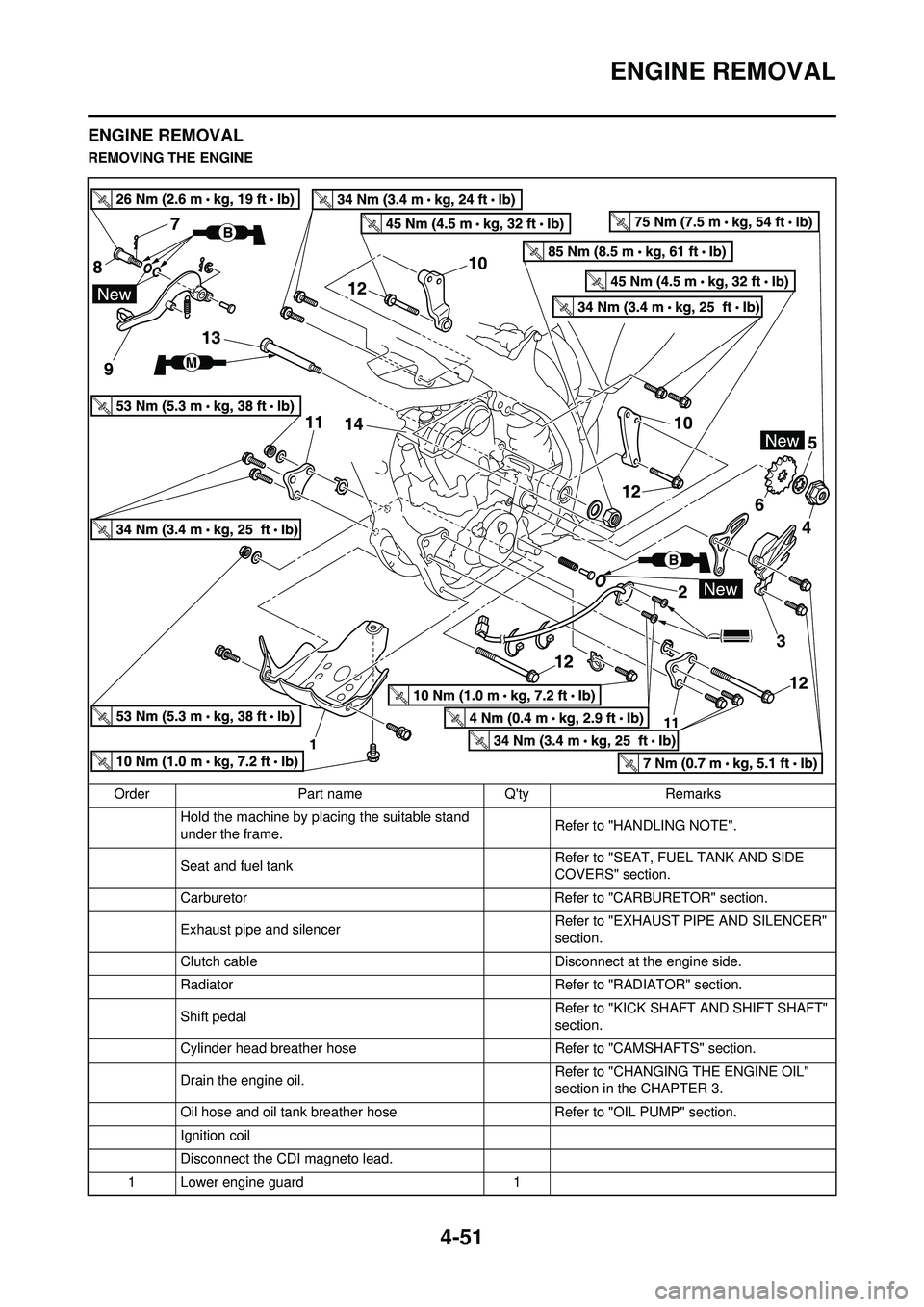
4-51
ENGINE REMOVAL
ENGINE REMOVAL
REMOVING THE ENGINEOrder Part name Q'ty Remarks Hold the machine by placing the suitable stand
under the frame. Refer to "HANDLING NOTE".
Seat and fuel tank Refer to "SEAT, FUEL TANK AND SIDE
COVERS" section.
Carburetor Refer to "CARBURETOR" section.
Exhaust pipe and silencer Refer to "EXHAUST PIPE AND SILENCER"
section.
Clutch cable Disconnect at the engine side.
Radiator Refer to "RADIATOR" section.
Shift pedal Refer to "KICK SHAFT AND SHIFT SHAFT"
section.
Cylinder head breather hose Refer to "CAMSHAFTS" section.
Drain the engine oil. Refer to "CHANGING THE ENGINE OIL"
section in the CHAPTER 3.
Oil hose and oil tank breather ho seRefer to "OIL PUMP" section.
Ignition coil
Disconnect the CDI magneto lead.
1 Lower engine guard 1
Page 185 of 196
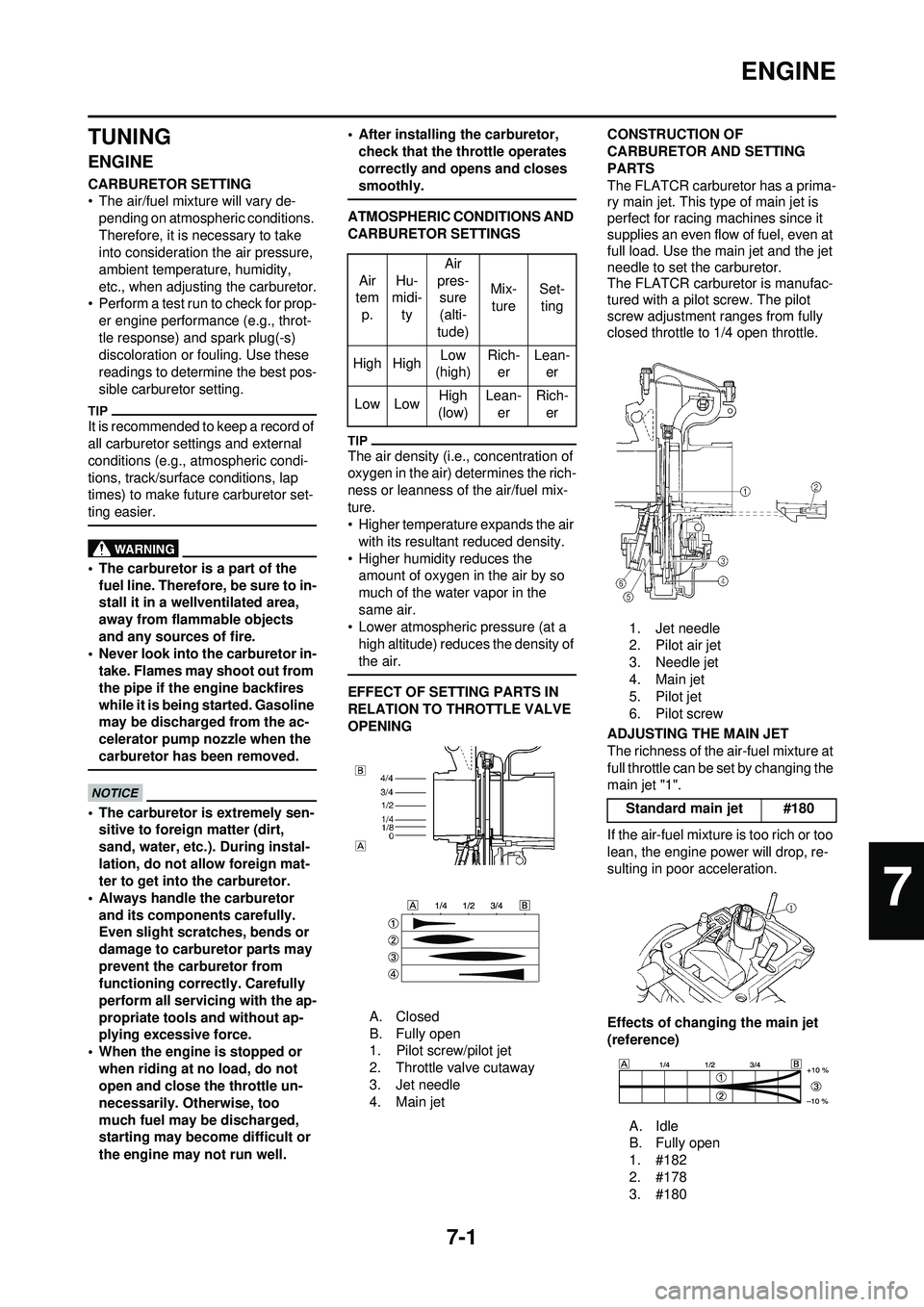
7-1
ENGINE
TUNING
ENGINE
CARBURETOR SETTING
• The air/fuel mixture will vary de-pending on atmospheric conditions.
Therefore, it is necessary to take
into consideration the air pressure,
ambient temperature, humidity,
etc., when adjusting the carburetor.
• Perform a test run to check for prop- er engine performance (e.g., throt-
tle response) and spark plug(-s)
discoloration or fouling. Use these
readings to determine the best pos-
sible carburetor setting.
It is recommended to keep a record of
all carburetor settings and external
conditions (e.g., atmospheric condi-
tions, track/surface conditions, lap
times) to make future carburetor set-
ting easier.
• The carburetor is a part of the fuel line. Therefore, be sure to in-
stall it in a wellventilated area,
away from flammable objects
and any sources of fire.
• Never look into the carburetor in- take. Flames may shoot out from
the pipe if the engine backfires
while it is being started. Gasoline
may be discharged from the ac-
celerator pump nozzle when the
carburetor has been removed.
• The carburetor is extremely sen-sitive to foreign matter (dirt,
sand, water, etc.). During instal-
lation, do not al low foreign mat-
ter to get into the carburetor.
• Always handle the carburetor and its components carefully.
Even slight scratches, bends or
damage to carburetor parts may
prevent the carburetor from
functioning correctly. Carefully
perform all servicing with the ap-
propriate tools and without ap-
plying excessive force.
• When the engine is stopped or when riding at no load, do not
open and close the throttle un-
necessarily. Otherwise, too
much fuel may be discharged,
starting may become difficult or
the engine may not run well. • After installing the carburetor,
check that the throttle operates
correctly and opens and closes
smoothly.
ATMOSPHERIC CONDITIONS AND
CARBURETOR SETTINGS
The air density (i.e., concentration of
oxygen in the air) determines the rich-
ness or leanness of the air/fuel mix-
ture.
• Higher temperature expands the air with its resultant reduced density.
• Higher humidity reduces the amount of oxygen in the air by so
much of the water vapor in the
same air.
• Lower atmospheric pressure (at a
high altitude) reduces the density of
the air.
EFFECT OF SETTING PARTS IN
RELATION TO THROTTLE VALVE
OPENING
A. Closed
B. Fully open
1. Pilot screw/pilot jet
2. Throttle valve cutaway
3. Jet needle
4. Main jet CONSTRUCTION OF
CARBURETOR AND SETTING
PARTS
The FLATCR carburetor has a prima-
ry main jet. This type of main jet is
perfect for racing machines since it
supplies an even flow of fuel, even at
full load. Use the main jet and the jet
needle to set the carburetor.
The FLATCR carburetor is manufac-
tured with a pilot screw. The pilot
screw adjustment ranges from fully
closed throttle to 1/4 open throttle.
1. Jet needle
2. Pilot air jet
3. Needle jet
4. Main jet
5. Pilot jet
6. Pilot screw
ADJUSTING THE MAIN JET
The richness of the air-fuel mixture at
full throttle can be set by changing the
main jet "1".
If the air-fuel mixture is too rich or too
lean, the engine power will drop, re-
sulting in poor acceleration.
Effects of changing the main jet
(reference)
A. Idle
B. Fully open
1. #182
2. #178
3. #180
Air
tem p. Hu-
midi- ty Air
pres- sure
(alti-
tude) Mix-
ture Set-
ting
High High Low
(high) Rich-
er Lean-
er
Low Low High
(low) Lean-
er Rich-
er
Standard main jet #180
7
Page 187 of 196
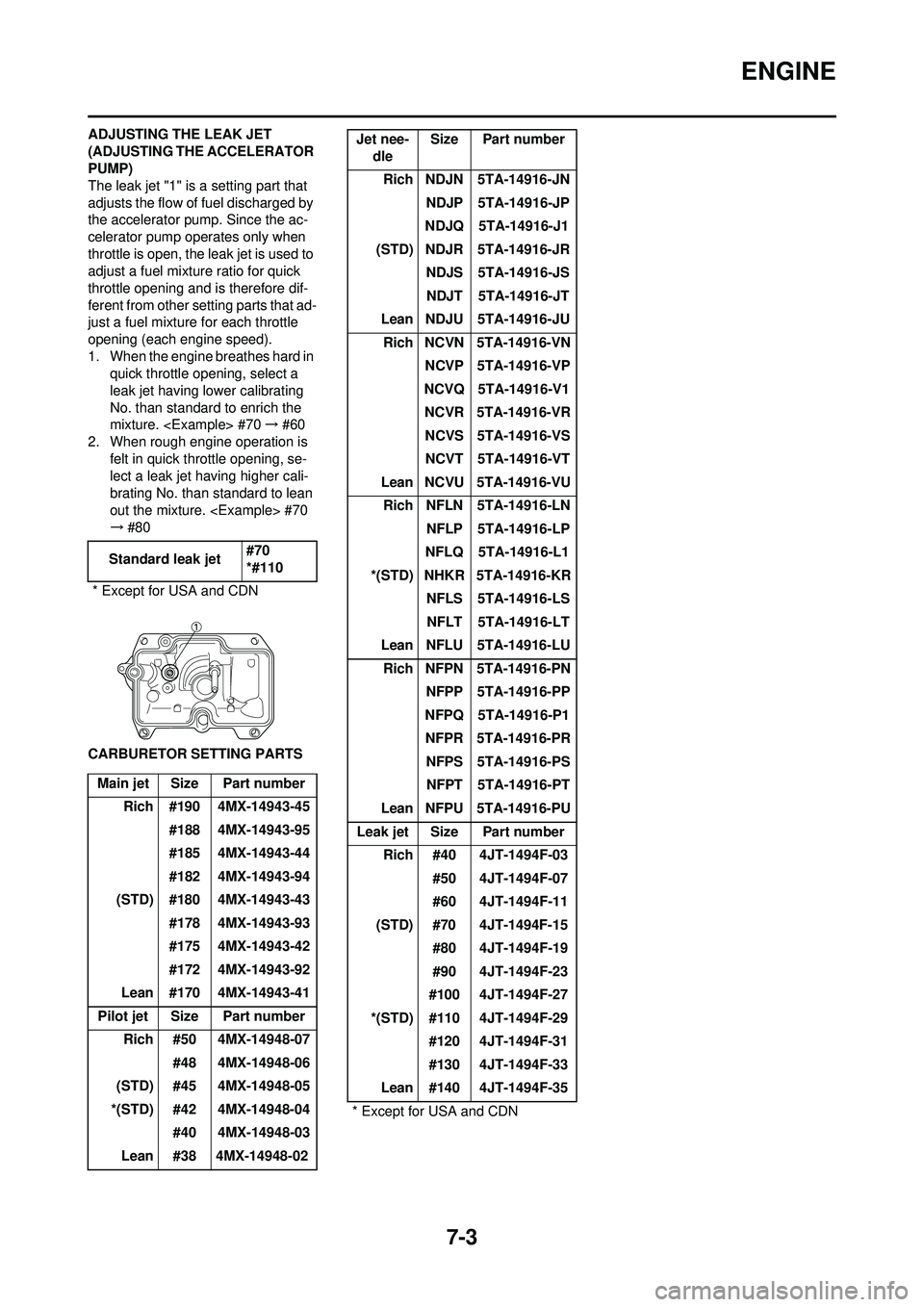
7-3
ENGINE
ADJUSTING THE LEAK JET
(ADJUSTING THE ACCELERATOR
PUMP)
The leak jet "1" is a setting part that
adjusts the flow of fuel discharged by
the accelerator pump. Since the ac-
celerator pump operates only when
throttle is open, the leak jet is used to
adjust a fuel mixture ratio for quick
throttle opening and is therefore dif-
ferent from other setting parts that ad-
just a fuel mixture for each throttle
opening (each engine speed).
1. When the engine breathes hard in quick throttle opening, select a
leak jet having lower calibrating
No. than standard to enrich the
mixture.
2. When rough engine operation is
felt in quick throttle opening, se-
lect a leak jet having higher cali-
brating No. than standard to lean
out the mixture.
→#80
CARBURETOR SETTING PARTS Standard leak jet
#70
*#110
* Except for USA and CDN
Main jet Size Part number Rich #190 4MX-14943-45 #188 4MX-14943-95
#185 4MX-14943-44
#182 4MX-14943-94
(STD) #180 4MX-14943-43 #178 4MX-14943-93
#175 4MX-14943-42
#172 4MX-14943-92
Lean #170 4MX-14943-41
Pilot jet Size Part number Rich #50 4MX-14948-07 #48 4MX-14948-06
(STD) #45 4MX-14948-05
*(STD) #42 4MX-14948-04 #40 4MX-14948-03
Lean #38 4MX-14948-02Jet nee- dle Size Part number
Rich NDJN 5TA-14916-JN NDJP 5TA-14916-JP
NDJQ 5TA-14916-J1
(STD) NDJR 5TA-14916-JR NDJS 5TA-14916-JSNDJT 5TA-14916-JT
Lean NDJU 5TA-14916-JU Rich NCVN 5TA-14916-VN NCVP 5TA-14916-VP
NCVQ 5TA-14916-V1 NCVR 5TA-14916-VRNCVS 5TA-14916-VSNCVT 5TA-14916-VT
Lean NCVU 5TA-14916-VU Rich NFLN 5TA-14916-LN NFLP 5TA-14916-LP
NFLQ 5TA-14916-L1
*(STD) NHKR 5TA-14916-KR NFLS 5TA-14916-LSNFLT 5TA-14916-LT
Lean NFLU 5TA-14916-LU Rich NFPN 5TA-14916-PN NFPP 5TA-14916-PP
NFPQ 5TA-14916-P1 NFPR 5TA-14916-PR NFPS 5TA-14916-PSNFPT 5TA-14916-PT
Lean NFPU 5TA-14916-PU
Leak jet Size Part number Rich #40 4JT-1494F-03 #50 4JT-1494F-07
#60 4JT-1494F-11
(STD) #70 4JT-1494F-15 #80 4JT-1494F-19
#90 4JT-1494F-23
#100 4JT-1494F-27
*(STD) #110 4JT-1494F-29 #120 4JT-1494F-31
#130 4JT-1494F-33
Lean #140 4JT-1494F-35
* Except for USA and CDN
Page 188 of 196
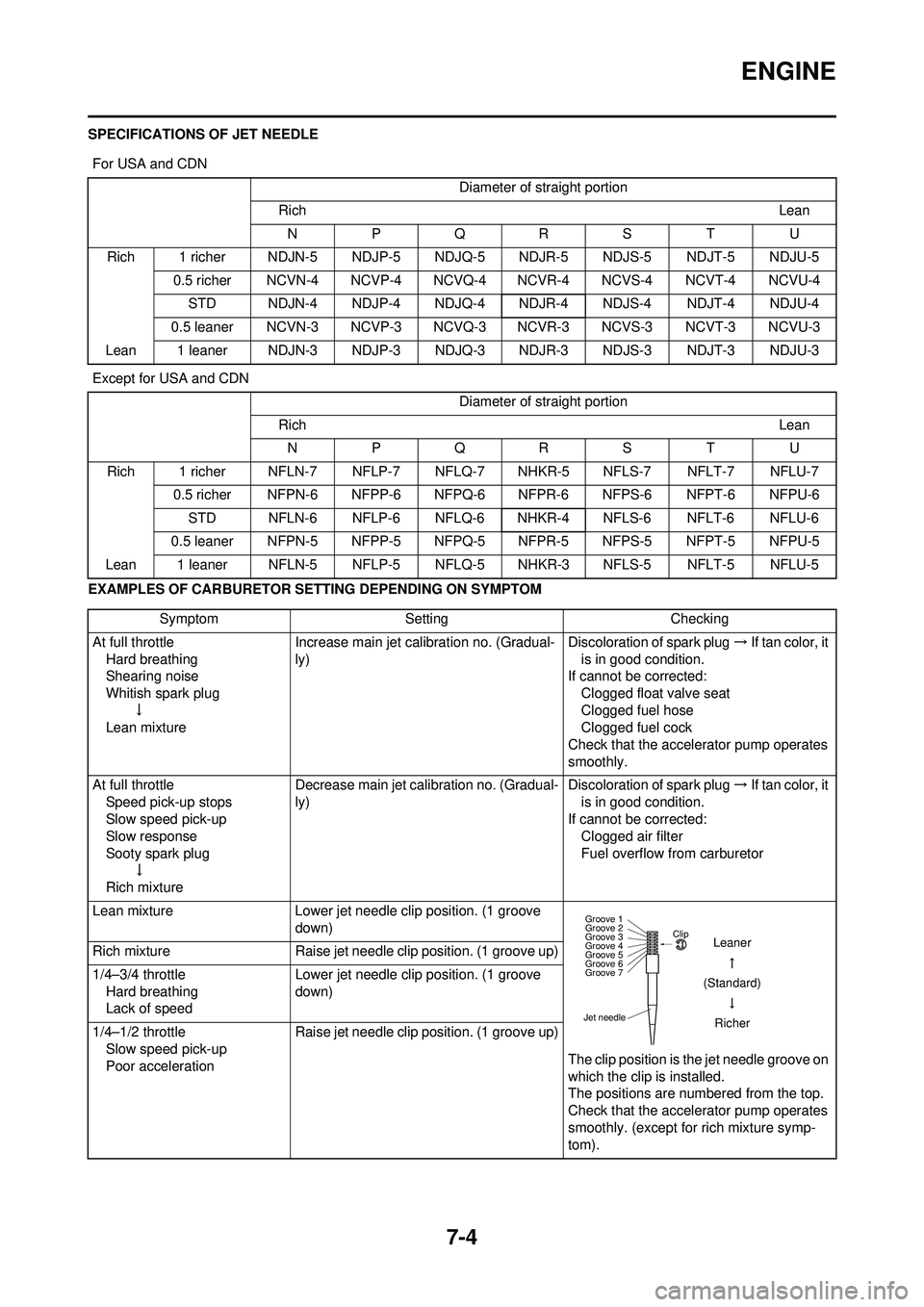
7-4
ENGINE
SPECIFICATIONS OF JET NEEDLE
EXAMPLES OF CARBURETOR SETTING DEPENDING ON SYMPTOM For USA and CDN
Diameter of straight portion
Rich Lean
NPQRS TU
Rich 1 richer NDJN-5 NDJP-5 NDJQ-5 NDJR-5 NDJS-5 NDJT-5 NDJU-5 0.5 richer NCVN-4 NCVP-4 NCVQ-4 NCVR-4 NCVS-4 NCVT-4 NCVU-4STD NDJN-4 NDJP-4 NDJQ-4 NDJR-4 NDJS-4 NDJT-4 NDJU-4
0.5 leaner NCVN-3 NCVP-3 NCVQ-3 NCVR-3 NCVS-3 NCVT-3 NCVU-3
Lean 1 leaner NDJN-3 NDJP-3 NDJQ-3 NDJR-3 NDJS-3 NDJT-3 NDJU-3
Except for USA and CDN Diameter of straight portion
Rich Lean
NPQRS TU
Rich 1 richer NFLN-7 NFLP-7 NFLQ-7 NHKR-5 NFLS-7 NFLT-7 NFLU-7 0.5 richer NFPN-6 NFPP-6 NFPQ-6 NFPR-6 NFPS-6 NFPT-6 NFPU-6STD NFLN-6 NFLP-6 NFLQ-6 NHKR-4 NFLS-6 NFLT-6 NFLU-6
0.5 leaner NFPN-5 NFPP-5 NFPQ-5 NFPR-5 NFPS-5 NFPT-5 NFPU-5
Lean 1 leaner NFLN-5 NFLP-5 NFLQ-5 NHKR-3 NFLS-5 NFLT-5 NFLU-5
Symptom Setting Checking
At full throttle Hard breathing
Shearing noise
Whitish spark plug ↓
Lean mixture Increase main jet calibration no. (Gradual-
ly)
Discoloration of spark plug
→If tan color, it
is in good condition.
If cannot be corrected: Clogged float valve seat
Clogged fuel hose
Clogged fuel cock
Check that the accelerator pump operates
smoothly.
At full throttle Speed pick-up stops
Slow speed pick-up
Slow response
Sooty spark plug
↓
Rich mixture Decrease main jet calibration no. (Gradual-
ly)
Discoloration of spark plug
→If tan color, it
is in good condition.
If cannot be corrected: Clogged air filter
Fuel overflow from carburetor
Lean mixture Lower jet needle clip position. (1 groove
down)
The clip position is the jet needle groove on
which the clip is installed.
The positions are numbered from the top.
Check that the accelerator pump operates
smoothly. (except for rich mixture symp-
tom).
Rich mixture
Raise jet needle clip position. (1 groove up)
1/4–3/4 throttle Hard breathing
Lack of speed Lower jet needle clip position. (1 groove
down)
1/4–1/2 throttle Slow speed pick-up
Poor acceleration Raise jet needle clip position. (1 groove up)
Jet needleClip
Groove 7 Groove 6
Groove 5
Groove 4
Groove 3
Groove 2
Groove 1
Leaner
(Standard) Richer